The best gooseberry varieties for the Urals and Siberia: description and reviews
The best gooseberry varieties for Siberia and the Urals are frost-resistant and immune. Otherwise, the plant will be susceptible to powdery mildew, rot, anthracnose and freeze in the cold winter. Sweet varieties are also in demand. The berries grow juicy and tasty and are used for cooking. Another important criterion is prickliness. Few people want to scratch their hands while harvesting. All this and more is recommended to be taken into account when choosing a suitable variety.
The best gooseberry varieties for the Urals
For the Urals, frost-resistant varieties with immunity from diseases are chosen. The region has short and cool summers and long and frosty winters. Frequent frosts, winds and rains.
To grow a rich gooseberry harvest, it is recommended to pay attention to fertilizing. Summer residents regularly spray the bushes with a solution of copper sulfate and add mineral and organic complexes to the soil. All this protects the gooseberry from temperature changes, diseases and pests.
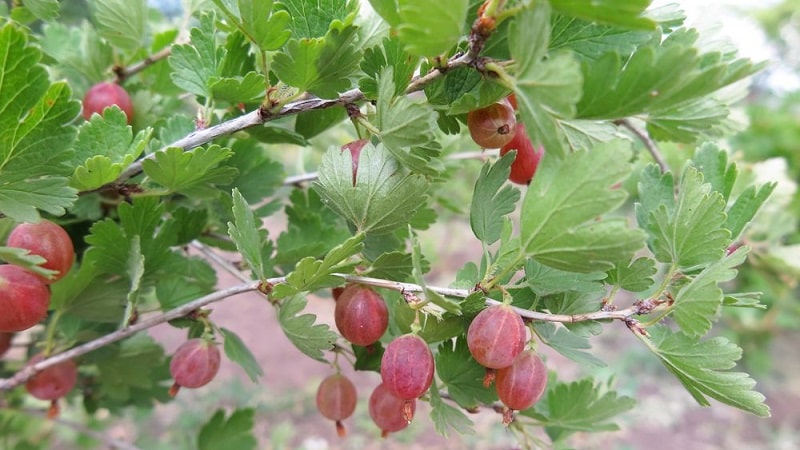
Resistant to powdery mildew
Powdery mildew is a common fungal disease that appears as a white coating on leaves and shoots. If symptoms are not detected in time, the plant withers, the fruits become covered with ulcers and rot. The bush stops growing. The causes of powdery mildew are contaminated soil, high humidity, weeds and insects.
Ural emerald
An early-ripening, winter-hardy gooseberry variety, Ural emerald, is unpretentious in cultivation. The bushes are compact, medium-sized, with a neat crown.The branches are thick and covered with thorns. The berries are round-oval, pointed at the tips, elastic. The color is rich green, the gooseberries shine through in the sun. The weight of the berry is from 3 to 7 g, the peel is smooth and dense. The taste is sweet with a pleasant sourness, rated 5 points out of 5. The pulp is pleasant and tender. The yield of Ural emerald is from 6 to 10 kg per plant.
Prune
Early ripening, universal in use. The height of the bush is about 1.5 m, the shoots are curved and covered with small thorns. The berries are round, weighing up to 4 g, the peel is smooth, without pubescence. The color is dark purple with a thin waxy coating; when fully ripe, the gooseberry turns black. The taste is pleasant, berry, with sourness. Productivity is from 2 to 4 kg of gooseberries per bush. Prunes are distinguished by transportability, immunity, and commercial qualities.
The sweetest
Sweet gooseberry good in any form: the berries are eaten fresh, made into compotes and jam, frozen for the winter, added to pies and muffins. Juicy and sweet varieties with a rich berry aroma are popular among summer residents.
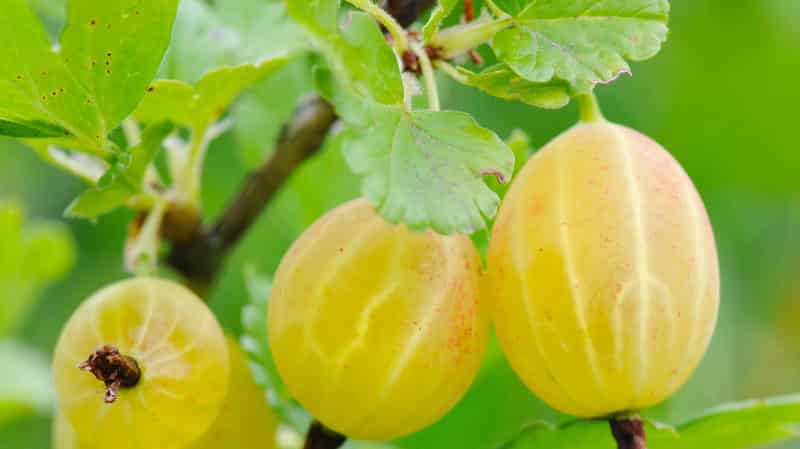
Krasnoslavyansky
The bushes are compact and neat. The shoots along their entire length are covered with medium-sized thorns. Krasnoslavyansky belongs to the mid-season varieties. The fruits are oval-round, weighing from 4 to 6 g, the peel is of medium density with thin pubescence. The pulp is sweet and sour, tasty, rated 5 points. Productivity is from 4 to 6 kg per bush, depending on growing conditions and weather. Fruits well in warm areas with nutritious soil. It is important to remember that gooseberries do not take root well in acidic soils.
Cooperator
A dense and at the same time compact bush looks original and decorates the area. The ripening period is average. The thorniness is below average, the fruits are large, weighing 4-8 g.The taste is sweet with a bright aroma; the harvest is used to make jams and preserves. Summer residents collect from 4 to 7 kg of fruits from a bush. The color of gooseberries is pink-burgundy, with transparent veins. The cooperator is resistant to common diseases - anthracnose and powdery mildew, and is rarely damaged by insect pests.
Interesting! Sweet berries make delicious confiture. For preparation you need gooseberries, water and sugar. Thick and aromatic confiture is used as a filling for pancakes or croissants, and is also added to milk porridges or simply spread on bread.
No thorns
To avoid injuring their hands during harvesting, summer residents plant varieties without thorns. The process of growing and caring becomes more enjoyable.
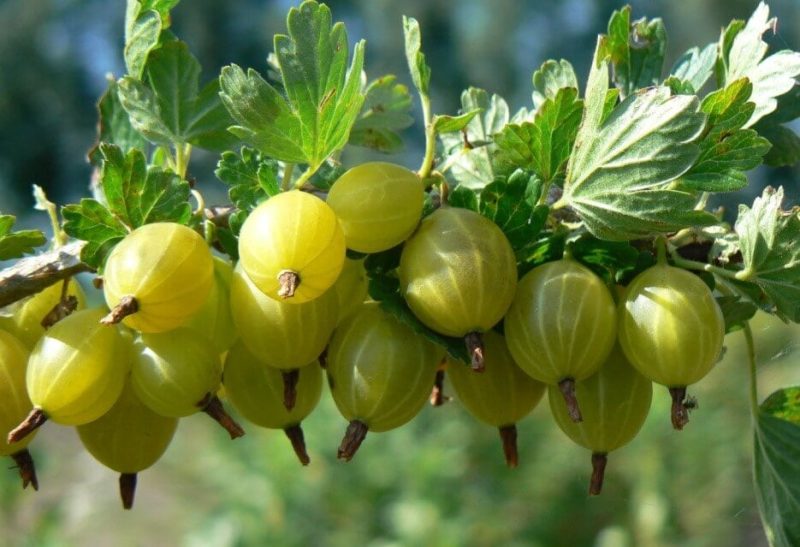
Harlequin
The mid-late variety is distinguished by spreading shoots and large leaves. The fruits are one-dimensional, oval-round, weighing from 2 to 6 g. The taste is sweet and sour, pleasant. The color of the berries is cherry-black, attractive, with a faint waxy coating. Harlequin is winter-hardy and is weakly affected by fungal and viral diseases. Resistant to sudden weather changes and universal in use. The harvest is used for long-term storage and sale: thanks to the thick peel, the fruits do not crack during transportation.
Vladil
A mid-early, unpretentious variety to grow. The shoots are slightly spreading, the leaves are large, the height of the bush is average. The fruits are dark brown, weighing about 3 g, the peel is dense, with a waxy coating. The taste is dessert, sweet and sour. The stalks are thin and long. The Vladil variety is slightly affected by insect pests, including the sawfly beetle. Productivity - from 6 to 8 kg per bush. The advantages of the variety include self-fertility - Vladil does not need pollinating bushes.
Varieties for Siberia
For planting in Siberia, varieties are selected that can withstand temperatures down to -40°C. Otherwise, the plants will freeze, which will negatively affect the yield, or even die. It is recommended to cover the bushes for the winter to prevent the buds from freezing. Otherwise care growing Siberian gooseberries is no different from growing berries in other regions of the country.
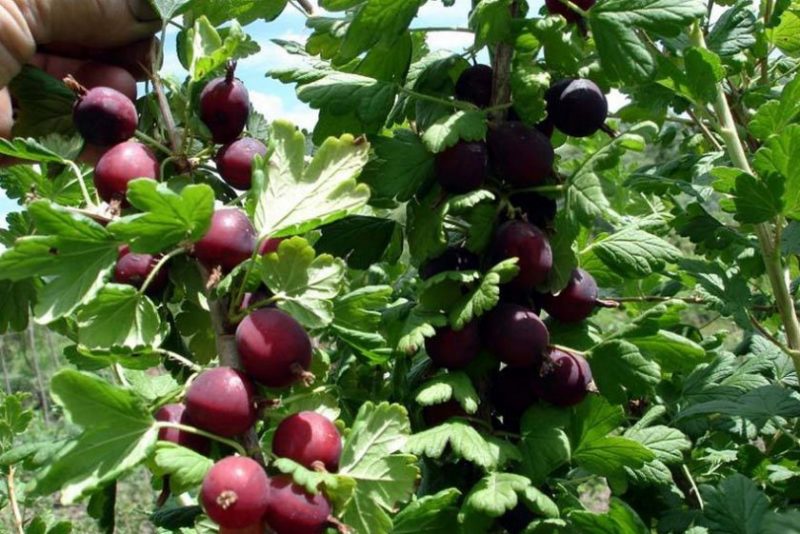
Resistant to powdery mildew
Powdery mildew is easy to notice with the naked eye, so gardeners regularly inspect the bushes for symptoms. If dew is not detected in time, it will destroy up to 70% of the crop. For planting in Siberia, gardeners recommend the Northern Captain and White Nights varieties.
Northern captain
Mid-season frost-resistant variety. The bushes are powerful and spreading, so spacious areas are allocated for them. The shoots are long, the thorniness is medium. The berries are round, regular in shape, burgundy, and have a thick peel. The taste is harmonious and sweet. After ripening, the Northern Captain does not crumble or crack, and hangs on the branches. It bears fruit consistently; from 8 to 12 kg of ripe and juicy berries are harvested from the plant every year. Gooseberries are rarely affected by insects and do not cause problems in cultivation.
White Nights
An early ripening variety with small bushes and thin shoots. The fruits are yellow-green, round in shape, weight - about 3 g. There is a waxy coating and slight pubescence on the surface. The pulp is tender, jelly-like, the taste is harmonious, sweet and sour. The yield of the variety is from 3 to 5 kg per plant. Gooseberries are self-fertile, drought-resistant, and tolerate sudden drops in temperature. Among the disadvantages, strong thorniness is noted, so gloves are required during harvesting.
Attention! Despite the immunity of gooseberries, it is recommended to carry out preventive measures.Summer residents regularly weed the soil, remove plant debris and burn them. Fertilizing with phosphorus-potassium fertilizers increases resistance to the pathogen.
The sweetest
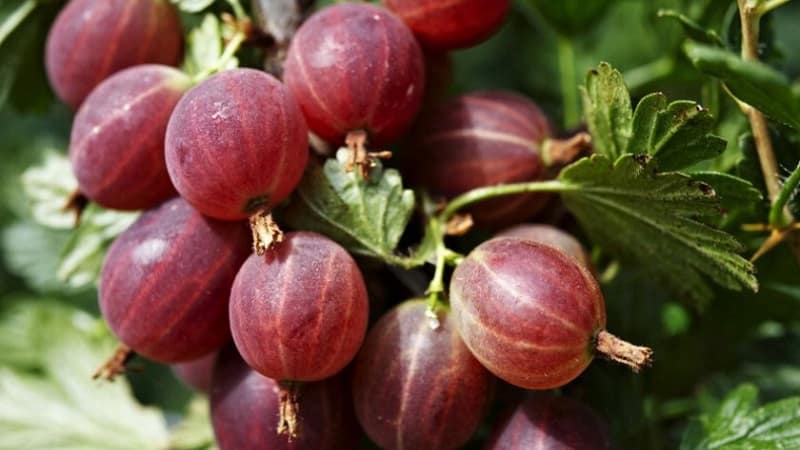
Sweet varieties have always occupied a special place, because many summer residents pay attention to taste when choosing. For planting in Siberia, the gooseberry varieties Russian Yellow and Candy are recommended.
Russian yellow
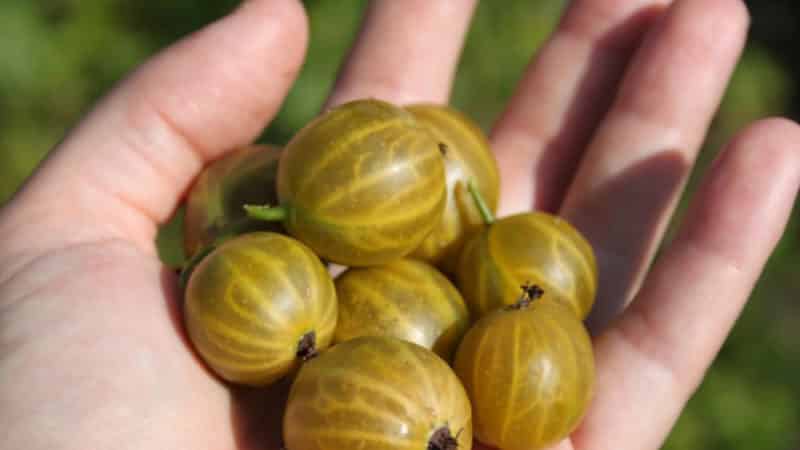
The bushes are compact and neat, so many summer residents plant Russian yellow for decorative purposes. The thorniness is weak, the shoots are straight. After ripening, the fruits do not fall off and retain their marketability and taste. The weight of the berry is 5-7 g, the color is yellow-light green, the skin is thin but durable. There is a slight waxy coating, the stalk is thin and long. The taste is pleasant, sweet and sour. The ripening period is average, the yield is from 4 kg of berries per season. Russian yellow is easy to care for, tolerates long-term lack of moisture, is drought-resistant and frost-resistant.
Candy
The self-fertile mid-season variety tolerates cold winters and rarely gets sick. The height of the upright bush is 1 m, the shoots are green and curved. The weight of the berry is 3-6 g, round shape, pink color. Light veins are visible on the berries. The pulp is dense, the taste is sweet and sour, the aroma is pleasant. Tasting score - 5 points. Productivity - from 2 to 6 kg per bush. The ripening period is extended - from mid-June to August. Ripe gooseberries hang on the bushes for 2-3 weeks. Desserts and pastries are prepared from the berries, and sweet winter preparations are made.
No thorns
Popular varieties of thornless gooseberries are Black Cherkashina and Beryl. They are not only easy to care for and safe during harvesting, but also have high taste and stable yield.
Black Cherkashina
The mid-late variety is distinguished by early fruiting. The plant is medium-sized, the shoots are spreading, the leaves are large, bright green. The berries are pear-shaped, burgundy-black with a waxy coating. Weight - about 2 g, the pulp is sweet and sour, pleasant to the taste. There are few seeds, the stalk is thin. Black Cherkashina gooseberry is resistant to septoria and anthracnose and is weakly affected by insect pests. The berries are used to make homemade wine and tincture, as well as fresh or frozen.
Beryl
Beryl belongs to the mid-late varieties. The bush is tall, dense and spreading. The leaves are large, gray-green in color. The weight of the berry is from 4 to 6 g, the color is green, there is a waxy coating. The skin is thin, the stalk is of medium length. Malachite winter-hardy and drought-resistant, rarely affected by powdery mildew. Beryl is valued for its commercial and taste qualities, keeping quality and transportability. Gooseberries are grown by amateur gardeners and experienced farmers.
Ripening dates in the Urals and Siberia
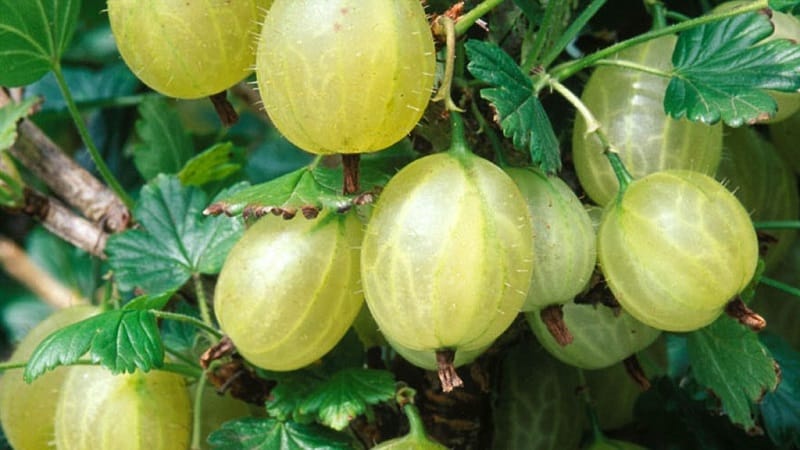
When do gooseberries ripen? In the Urals and Siberia, early and middle varieties will ripen by mid-July, late ones by early or mid-August. The ripening period is influenced by external conditions: length of summer, air temperature, precipitation, frost, gusty cold winds. If the summer is warm and sunny and the winter is mild, the berries will ripen on time. If the winter was long and frosty, and the summer was rainy and cloudy, the harvest may be delayed by 1-2 weeks.
Agrotechnical conditions also influence the ripening period of berries. Gooseberries love moisture, but do not tolerate close proximity to groundwater. Bushes are demanding of light, so seedlings are planted in spacious and sunny areas; in the shade there is a high risk of developing diseases.If the bush is older than 5 years, dry and drooping branches are cut out annually. If these recommendations are not followed, the ripening time of the berries will shift.
Attention! The ripeness of gooseberries is determined by the elasticity of the fruit, strong peel, and waxy coating. Ripe berries exude a pleasant sweet aroma.
Conclusion
Varieties common in the Urals Ural emerald, Harlequin, Krasnoslavyansky, Vladil. Early and middle varieties rarely get sick, tolerate drought and frost, and are unpretentious in care. For planting in Siberia, it is recommended to choose the varieties Candy, Russian Yellow, and Northern Captain. They can withstand temperatures as low as -40°C and are rarely affected by diseases and pests.
When do gooseberries ripen in Siberia and the Urals? Early ripening varieties in July, late ripening varieties in August. Ripe fruits do not fall off the bushes for 2-3 weeks. When purchasing a seedling, it is recommended to pay attention to reviews of varieties for the Urals and Siberia.